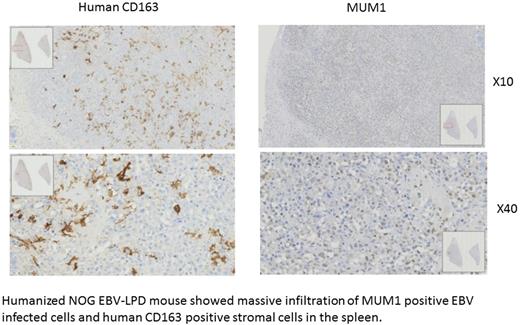Abstract
Several mouse models have been developed for diffuse large B cell lymphoma (DLBCL) such as Emu-cmyc Transgenic mice, BCL6 knock in mice, λ-myc mice and so on.
However, the histopathology of these mice does not fully recapitulate that of the human DLBCL. For non- GC type in particular, it is not an exaggeration to say that none of these mice show the similarity to it.
The xenograft model in which human tumor cells are transplanted into immunodeficient mice which is frequently used for the pre-clinical study for new drug, is also problematic in that the tumor cells derive form human while the cancer microenvironment from the mouse.
We established the new mouse model which well recaptilates human non GC DLBCL. Human umbilical cord blood was transplanted into NOD/Shi-scid-IL2Rγnull mice(NOG mice), which is called as humanized NOG mice. The humanized NOG mice are infected with low dose EBV that infects only the primates. These mice develop EBV+ lymphoproliferative disease (LPD). We analyzed the histopathology of the LPD and compared with EBV+ DLBCL.
Both EBV positive tumor cells are Mum 1 positive Bcl 6 negative CD 10 negative corresponding to non-GC DLBCL. Both tumor microenvironments showed massive infiltrate of CD 163 positive macrophages. (Figure) The localization of the cells which express cytokines such as IFN beta, TNF and IL-10 are overlapped between them.
Particularly, the LPD which EBV infected humanized mice develops consists of not only EBV infected human CD20 positive cells but also human stromal cells such as human CD163 positive macrophages.
In conclusion, the LPD developed in EBV infected humanized mice well recapitulate human non GC DLBCL and can be a useful model mouse for drug discovery targeting tumor microenvironment including immunocheck point drugs.
Kotani: Janssen Pharma: Research Funding.
Author notes
Asterisk with author names denotes non-ASH members.


